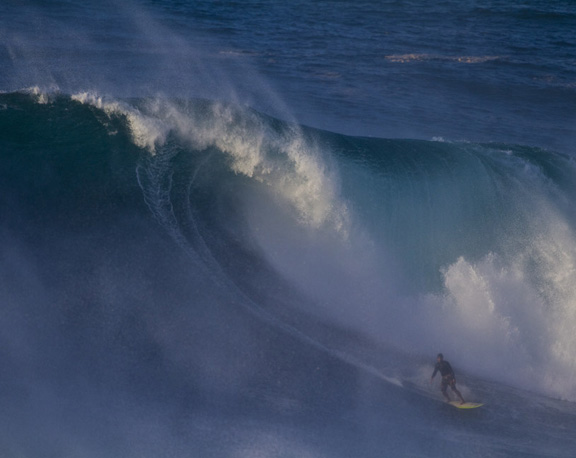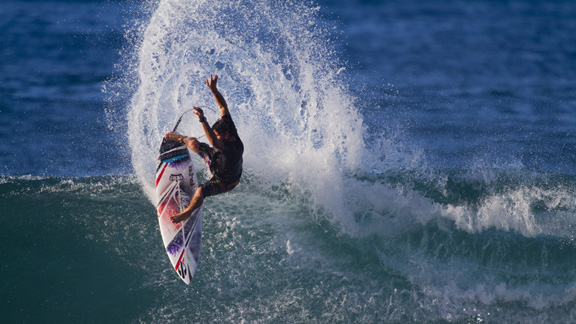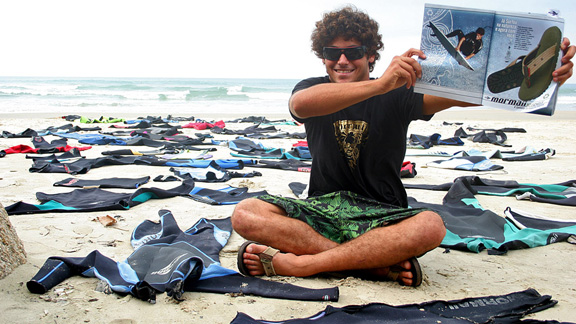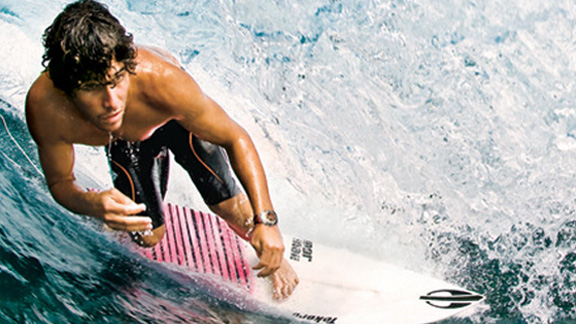In late March, at the O'Neill Cold Water Classic in Tasmania, a surfer named Marco Giorgi felled world No. 3 Jordy Smith en route to a third place finish. If you look up Giorgi on the ASP web site, you will find that he is currently No. 40 in the Men's World Ranking and out of 500 guys, he is the only one with the country initials "URY" after his name.
Now Google that abbreviation. You'll have to dig through nine pages of assorted references before you find that URY stands for Uruguay, a small, South American country of roughly three million people that sits on the Atlantic, sandwiched between regional powerhouses Brazil and Argentina. How a twenty two year old goes from a sleepy Uruguayan fishing town to knocking on the door of the top thirty-two is something of a mystery. ESPN snagged him after a trip to Bali for an explanation.

James ThistedGiorgi, comfortable at Waimea as well.
What were you doing in Bali?
I was on my way back from a few weeks in Indo. I was stranded there though, because I was supposed to fly through Europe on my way to Brazil and all the flights were cancelled because of the volcano in Iceland.
That was quite a mess. How old are you and where you are from?
I'm 23. I was born in Montevideo, Uruguay, and learned to surf in a little town on the Western coast called "La Paloma." When I was 11, my family moved to Garopaba, Brazil, and I've lived there ever since.
Was the move a career choice to help your surfing?
Not really. When I was eleven, there was a big economic crisis in Uruguay and Argentina. At the time, my father owned a business renting houses to Argentine tourists who came to Uruguay on vacation. The crisis left my father without clients, money or many options. Suddenly my parents didn't see much future in Uruguay, either for themselves or their family. Since we had always gone to Brazil on vacation, they decided to move us there, figuring that it would give my brother, my sister and I more options.
In the United States, we tend to hear a lot about Brazil and its world-class surfers. But most people know next to nothing about Uruguay. Can you tell us a little about the surf scene?
I think a lot of people that I talk to missed the geography class where they point out Uruguay on the map (laughs.) People always ask me where I'm from and I say: 'Uruguay.' Their response is usually: 'Where is that?'
 James ThistedGiorgi considers himself half Uruguayan and half Brazilian when he travels the world.
James ThistedGiorgi considers himself half Uruguayan and half Brazilian when he travels the world.So, not many people know this, but there are really good waves in Uruguay, very few crowds, and the people are super relaxed -- there's never any localism. The surf industry is small because the country is small, but at the same time, there are a lot of surfers "de corazón" -- people that support surf culture and love it just as much anyone who works in the industry.
How did being part of such a small surf scene influence you growing up?
On one hand, I'll never forget being young and suffering through the really cold winters in old wetsuits. But on the other hand, I love coming from a small town like La Paloma, because all the surfers know each other and everyone is friends.
How long have you been competing professionally?
This is my second year on the tour. Last year went very well for me -- I finished fifty-third (on the old WQS). With that result I can enter more important events that are worth more points and try to qualify for the Top 32.
A lot of surfers talk about how much of a grind the qualifying events are. What is your impression of the tour?
It's definitely hard. It never stops and you are always flying somewhere, making hotel reservations, and renting cars to drive I-don't-know-how-many hours between the airport and wherever you are going. This year I'll spend about nine months traveling with about a week at home each month. I feel like I spend a lot of time in planes (laughs.)
But it has also taken me to places I never thought I would go. Yes, it's tiring, but it's also incredible and I'm living my dream.
Most surfers travel with their countrymen. Since you are the only Uruguayan on tour, do you get lonely?
Since I've lived in Brazil for so long, I consider myself half Brazilian. Since my main sponsor is Mormailllink text (a Bazilian brand) and I travel with a lot of Brazilians -- Willian Cardoso, Alejo Muniz, Thiago Camarão, Ricardo Dos Santos, Jerônimo Vargas, and Júnior Faria. They are all good friends of mine and I feel really lucky to have good people to travel with. When you spend so much time traveling, it's great to have people that support you and understand you because they're living the same type of life.
Why do we see more good surfers coming out of Brazil than other countries in South America?
Surfing in gigantic in Brazil, whereas on the Pacific side of the continent it's still very new. Because Brazil is more established, they always get the best surfers coming down to ride in their country and there is also tons of rivalry because everyone wants to be the best.
Naturally, this produces more competitive surfers. Even though surfers in other Latin American countries have great sponsors, sometimes the sponsors won't give them the opportunities to do the tour. But the new generation of South American surfers -- guys like Gabriel Villarán and Cristóbal de Col (both from Peru) are starting to arrive.
 James ThistedGiorgi is sposored by Brazilian company Mormaii. And apparently, he's very grateful.
James ThistedGiorgi is sposored by Brazilian company Mormaii. And apparently, he's very grateful.No one was expecting you to beat Jordy Smith in the Round of 16 at the O'Neill Cold Water Classic in Tasmania, can you walk us through that heat?
I wasn't expecting it either (laughs). There was a lot of pressure with him being second in the world at the time. I was super nervous before the heat, but the second we got in the water, I knew that all I had to do was calm down and surf. Luckily, two good waves came to me and I won. When we got out of the water he came over, shook my hand and congratulated me. I told him he was my idol. (laughs)
A few weeks ago, we heard Jeremy Flores complain that surfing against the "big name" guys is more difficult for people who aren't as well known, do you experience that?
I've never felt that I was scored lower than someone because of where I'm from or who I am, but I think, in order to beat someone with a big name, I have to go above and beyond -- the burden of proof is on me to out surf them.
Being from South America, it can be difficult to make a name for yourself and sometimes the rest of the world makes it hard on you. But at the same time, I don't necessarily see that as an impediment. Latin American surfers have to know how to deal with this sort of pressure. We've got to show the world that we can surf, that we can make heats, and that no one is going to knock us down.
 Sebastian RojasWhile some surfers complain about the grind of qualifying life, Giorgi is thankful for every blue opportunity.
Sebastian RojasWhile some surfers complain about the grind of qualifying life, Giorgi is thankful for every blue opportunity.Brazilians are stereotyped as having a lot of national pride. Do you feel like you are representing Brazil or Uruguay when you surf?
Truthfully, I love both of my countries and would like the world to know that I came from a small town in Uruguay, but I'm out there representing myself -- I'm out their representing Marco Giorgi. I was born in Uruguay -- I'm proud of that, and I carry my flag around the world, but to me the important part is that I surf well and that people like my surfing, and support me. As long as I feel good about myself and what I'm doing, I think the respect will come.
-Interview and translation by ESPN Surfing's newest contributor, Tetsuhiko Endo. Endo is a NYC-based surfer and writer.























